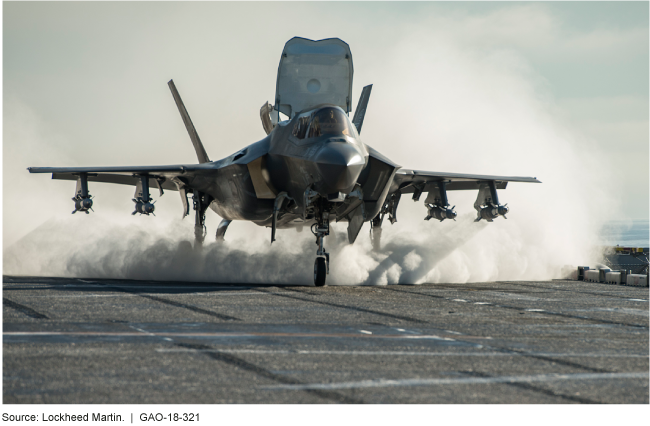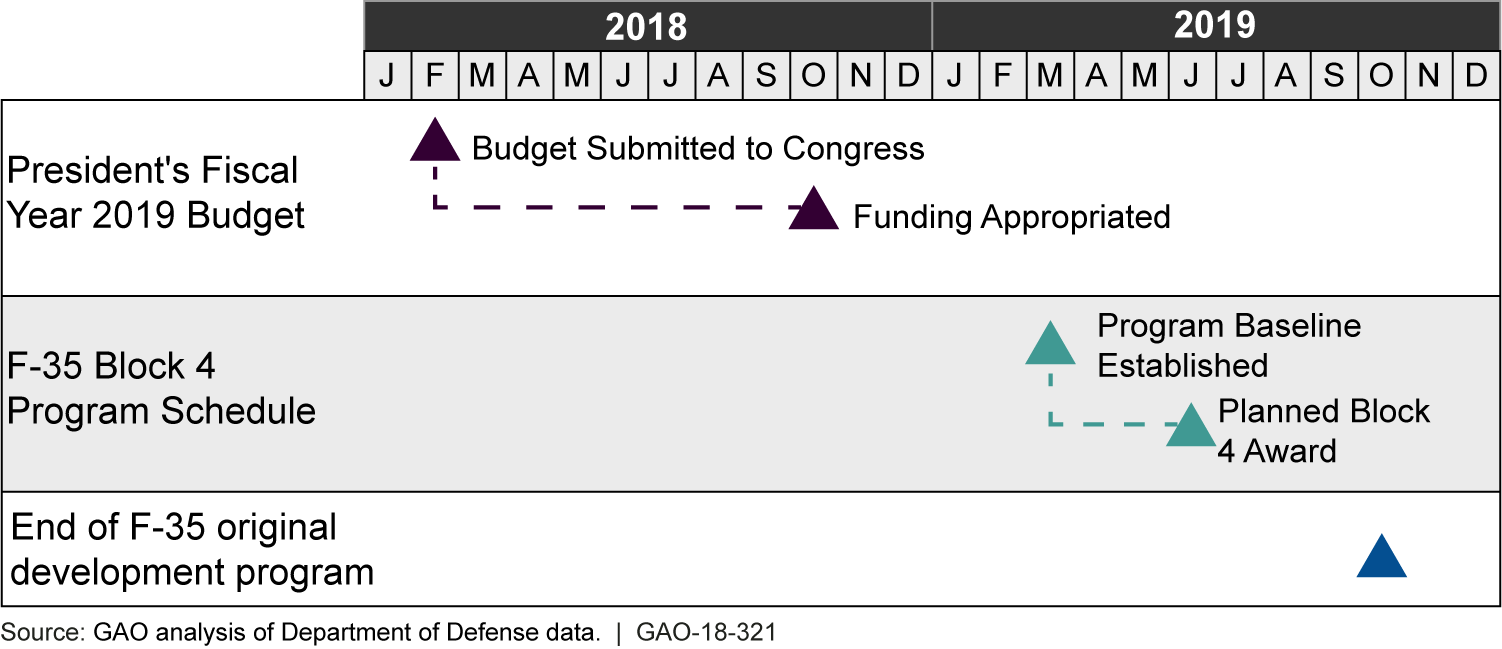F-35 Joint Strike Fighter: Development Is Nearly Complete, but Deficiencies Found in Testing Need to Be Resolved [Reissued with Revisions Jun. 13, 2018]
Fast Facts
DOD is getting closer to completing the F-35 program, but DOD's plan to move into full-rate production without fixing key deficiencies brings into question the reliability and affordability of the aircraft.
DOD has already requested $9.8 billion for 2019 and will ask for about $10.4 billion more per year over the next two decades.
Congress should consider withholding funding from the next increment of F-35 development until DOD provides an independent cost estimate, a technology assessment, and takes other actions. In addition, we recommended that DOD resolve critical aircraft deficiencies before moving to full-rate production.
An F-35B, the short takeoff and vertical landing variant for the Marine Corps, is shown landing on USS America.

Photo of an F-35 surrounded by white smoke landing.
Reissued with Revisions Jun 13, 2018This report was revised June 13, 2018 to correct four figures in table 1 on page 4.
Highlights
What GAO Found
The Department of Defense (DOD) has made progress in completing the F-35 baseline development program, but plans to finish testing later than expected.
F-35 Testing Schedule Is Delayed

DOD plans to defer resolving some critical deficiencies found in testing until after its full-rate production decision in October 2019, even though DOD's policy states that critical deficiencies generally will be resolved before then. Program officials stated it is reasonable to resolve some deficiencies while in production. Any associated rework could result in additional costs to the government.
DOD plans to spend billions of dollars to modernize the F-35 with new capabilities and is requesting $278 million to begin that process before establishing a sound business case—a baseline cost and schedule estimate.
Funding Request for F-35 Modernization, Known as Block 4, Is Premature

This timing could prompt Congress to make a funding decision before DOD can provide its business case. With these funds, DOD can award a contract, making a long-term commitment to Block 4, the costs of which are not fully understood.
Why GAO Did This Study
In 2019, DOD will decide whether to enter full-rate production for the F-35 aircraft, the most expensive and ambitious weapon acquisition program in U.S. military history. DOD has already requested the $9.8 billion it will need for 2019, and it will continue to request more over the next two decades—about $10.4 billion annually. However, the F-35 is just one program in DOD's vast acquisition portfolio, raising questions about its long-term affordability.
The National Defense Authorization Act for Fiscal Year 2015 included a provision for GAO to review the F-35 acquisition program until it reaches full-rate production. This is GAO's third report under this provision. It assesses progress of development and testing, including remaining deficiencies, and plans for spending on new capabilities.
To conduct this work, GAO reviewed and analyzed management reports and historical test data; discussed key aspects of F-35 development with program management and contractor officials; and compared acquisition plans to DOD policies and GAO acquisition best practices.
Reissued with Revisions Jun. 13, 2018
This report was revised June 13, 2018 to correct four figures in table 1 on page 4.Recommendations
Congress should consider providing in future appropriations that no funds shall be available for obligation for F-35 Block 4 until DOD provides a sound business case for the effort. GAO is making two recommendations to DOD, including that it resolve all critical deficiencies before full-rate production. DOD concurred with both recommendations and cited that it would resolve all critical deficiencies before its full-rate production decision.
Matter for Congressional Consideration
| Matter | Status | Comments |
|---|---|---|
| Congress should consider providing in future appropriations that no funds shall be available for obligation for F-35 Block 4 until DOD provides a report setting forth its complete acquisition program baseline for the Block 4 effort to the congressional defense committees. Such a report must reflect findings from (1) an independent cost estimate, (2) technology readiness assessments, (3) a test and evaluation master plan, (4) a system engineering plan, (5) a preliminary design review, and (6) an approved acquisition strategy. | In August 2018, Congress passed the National Defense Authorization Act (NDAA) for Fiscal Year 2019 (Public Law No: 115-232), which limited the program from obligating or expending more than 75 percent of funds authorized for the F-35 Continuous Capability Development and Delivery effort. This limitation would be in effect until 15 days after the Secretary of Defense submitted a detailed cost and schedule baseline for the program. The program submitted its F-35 Block 4 report to Congress in May 2019 which contained cost and schedule information, responding to this provision. |
Recommendations for Executive Action
| Agency Affected | Recommendation | Status |
|---|---|---|
| Department of Defense | The Secretary of Defense should direct the F-35 program office to resolve all critical deficiencies before making a full-rate production decision. (Recommendation 1) |
DOD concurred with our recommendation and stated that critical deficiencies would be resolved before full-rate production. DOD has made progress and resolved many deficiencies. We reported in July 2021 that there are only eight open category 1 deficiencies. According to a program official, the program plans to resolve those current deficiencies by the end of operational testing before the full-rate decision is finalized, a date which remains to be determined.
|
| Department of Defense |
Priority Rec.
The Secretary of Defense should direct the F-35 program office to identify what steps are needed to ensure the F-35 meets reliability and maintainability requirements before each variant reaches maturity and update the Reliability and Maintainability Improvement Program with these steps. (Recommendation 2) |
DOD concurred with our recommendation. While the F-35 variants did not meet reliability and maintainability (R&M) requirements before maturity, the program continues to demonstrate their commitment to R&M improvement. In September 2020, the program revised the F-35 Reliability and Maintainability Improvement Program Instruction, which noted specific and measurable R&M objectives. The updated Reliability and Maintainability Improvement Program also implements projects for design change, retrofit/modification, and process improvements to increase R&M of all components of the F-35 enterprise. Program officials also stated that they intend to continue to fund R&M improvement projects through the life of the F-35 program. We consider the program's sustained actions to improve F-35 R&M metrics as meeting the intent of our recommendation.
|
